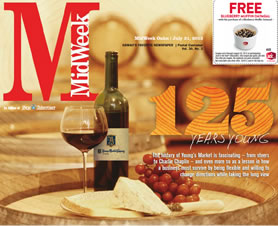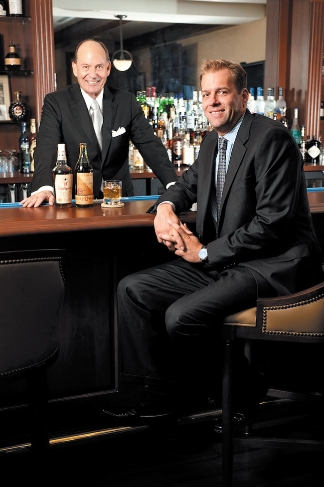125 Years Young
The history of Young’s Market is fascinating – from steers to Charlie Chaplin – and even more so as a lesson in how a business must survive by being flexible and willing to change directions while taking the long view
To say a company is 125 years old, as Young’s Market is, tells you little. But to understand how a company survived into its third century is truly a lesson from which every business person could learn.
mw-coveryoungsmarket-2
The story begins in the California of the 1880s, a time made famous in Steinbeck novels as Americans sought their fortune in the West, tiring of the overcrowded cities of the Eastern seaboard and dried out farms of the Midwest. They looked to start anew as their forefathers had, but instead of crossing the Atlantic, they had to traverse the Rocky Mountains.
Some sought gold in those mountains and panned for it in a multitude of streams, others thought they would find it in the soil that legend had it could grow any crop.
But the Youngs sought their fortune above the ground as they were cattlemen from the Midwest, four brothers who were sent to the “Left Coast” by their father Peter Young with two possessions: feed money for their cattle and his advice, “If you all stick together, nothing can lick ya.”
In 1888 they opened a meat business in the burgeoning city of Los Angeles, specializing in aged beef and Thanksgiving turkeys. Despite their early success with meat, life in the big city opened their eyes to possibilities outside of cattle, and they quickly added retail and wholesale sales of everything from salad dressings to sausage products.
They did not fall prey to the trap that the modern day Blockbusters and Borders and the ancient Romans succumbed to: an inability to evolve. For change is at the core of Young’s, a belief that still is held strong today by CEO Vern Underwood Jr.
“Change is something you do every day,” says Underwood. “If you fail to act, you get left behind.”
And change they did. In 1925 they opened their flagship store on the corner of 7th and Union as a testament to the opulence of the time. Four floors of Italian marble mosaics, gold-plated cash registers and delicacies from around the world were available for the rich and beautiful of Hollywood to come sample.
Luminaries of the silver screen including Charlie Chaplin, Johnny Weissmuller and Betty Grable all shopped here to try their exotic coffees, chocolates and confectionary delights.
Tycoon William Randolph Hearst had the Youngs supply his mansion at San Simeon with their sumptuous culinary treats, and when Charles Lindberg got married in New Jersey it was a Young’s cake that he had to have flown in for his nuptials.
Its mark could be seen everywhere from professional baseball teams to the founding of the legendary racetrack, Hollywood Park. So ubiquitous were the Young’s delivery trucks that the Marx Brothers spoofed them in their classic film Room Service.
Yet success is always fleeting, one never owns it, but just rents it for a while. Young’s had to evolve once more as the Great Depression brought a sharp downturn in the desires for the expensive and frivolous, so they expanded into average neighborhoods with a chain of Thriftimarts, gearing themselves toward the more pedestrian consumer. By the end of its retail run, they had 60 stores in the Southern California region.
The Crash of 1929 brought doom to many businesses, but it proved to be the spark that lit a fire under Congress to repeal Prohibition in 1933. While some may argue it was a selfish move by a government strapped for tax dollars, for Young’s it opened not just a new revenue stream, but a raging river that would lead to it being one of the top 200 largest private companies in America today.
The libertine years of the speakeasy gave way to the widespread acceptance of the fermented grape and the distilled grain. A government-mandated system of suppliers was setup with everyone trying to get their slice of the pie, and while most companies were looking for the quick buck, Young’s took a longer view.
Instead of snapping up every brand out there, they looked for exclusive rights with smaller distilleries. Names no one had heard of at the time like Bacardi rums and Cuervo, who made some oddly pronounced liquor from Mexico called tequila.
It was at this time that Vern Underwood Sr. joined the company and brought his favorite spirit from his time in college in Arizona to the general public. It struggled at first, but then Underwood noticed a local bar started ordering it five cases at a time. Upon investigating, he found the bartender had created a new drink named after a popular Mexican woman’s name, Margarita.
Having found his new angle for marketing the spirit, Cuervo took off in America. It became so popular that the Youngs eventually sold the national rights to it (only keeping their Western territories exclusively) and Underwood finding himself welcomed as an adopted son, and eventual son-in-law, as he married Adrienne, the daughter of the eldest Young, John.
By the onset of World War II, Young’s and their general manager Under-wood, decided to end the retail part of their business and focus solely on being wholesale suppliers. This did not garnish them with the celebrity consumers that had marked their early years, but it eliminated the overhead of storefronts during a decade marked by tightening belts.
This frugality paid off in the 1950s as America came roaring back to life with the West Coast being fueled by Young’s Huggins Coffee, which sold 12 million pounds in 1956, and their new most popular spirit, Smirnoff vodka. Sales were fueled by an ad campaign for Smirnoff that claimed “it would leave you breathless,” which perpetuated an urban myth that persists to this day.
“Right after the war, vodka took right off,” remembers Underwood Jr. of the success of the slogan. “So people would think they could go out for lunch and have vodka and you wouldn’t smell it on your breath!”
The ’60s found them expanding far from home into the Pacific when they purchased Better Brands on Oahu and eventually spread their liquor distributorships onto Maui and Kauai.
In 1990, after a century of ownership by the Young family, they sold out the business to their in-laws the Underwoods for a reported $130 million. In keeping with the Young’s tradition, the name remained, but the paradigm was shifted.
They shed the food divisions of their company, the meats to Con-Agra and its seafood business to Hunts Bros., to focus solely on liquor and wine distribution. The revolution that had begun with the 21st Amendment would singularly be informing their entrance into the 21st century.
Young’s last year had $2.6 billion in sales and according to Forbes is listed as the 171st largest private company in the U.S., but even with all their success, they still feel that pressure to keep up and evolve with the times.
Recently they turned over the helm of Hawaii operations to Philana Bouvier, who has made it her goal to transform the centenarian into a spry, Tweeting teenager ready for this era of social media.
Before her ascension, the managers of the company were not even texting, but under her they now all know the nuances of Facebook and the benefits of Twitter. Its offices at a Kau Street warehouse in Waipio, once drab and cubicle-filled, now include a fully operational kitchen to replace the microwave and a modern bar to showcase its products and conduct workshops for clients.
“Our goal in Hawaii is to be the best distributor we can. In the end it is all about Hawaii,” says Bouvier, who took over as the general manager in December of 2011. “We need to grow the economy for Hawaii and can do so by growing craft spirits, food challenges and improving mixology so that people who come to Hawaii for the experience, have one. We need to grow the experience and make it great. That to me is what this business is all about, making the experience great so that people will come back.”
So the Young’s business continues, hardly recognizable from the cattle farmers it started as, but as Under-wood Jr. gives way eventually to his son Chris, they can be sure that the lessons that brought them to where they are today are not forgotten.
“I don’t know what else to compare it to, what a unique company it is,” says Chris. “It is a special place to be. Everything we do here is long-term thinking; any family company thinks long term. I feel very compelled to position the company to be in a much better place 25 or 50 years from now. We are not going to sell, we will always be a family business. Young’s is gonna be around a long, long time.”







